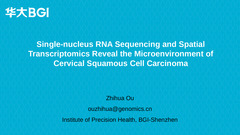Single-nucleus RNA Sequencing and Spatial Transcriptomics Reveal the Cervical Squamous Cell Carcinoma Microenvironment
编号:31
稿件编号:22 访问权限:仅限参会人
更新:2022-06-28 16:50:31 浏览:1318次
口头报告

报告开始:2022年07月23日 17:25 (Asia/Shanghai)
报告时间:15min
所在会议:[S5] 分会场5 » [S5-1] 单细胞组学技术开发与应用
摘要
Background: Cervical cancer is the fourth most common cancer affecting women’s health globally, especially in low- and middle-income regions. Despite the gradual application of HPV vaccines, effective treatment of high-grade invasive cervical cancer remains challenging in the coming decades. Infection of high-risk human papillomaviruses (HPVs), especially HPV16, is responsible for 60%-70% of the cervical cancer cases, the majority of which are cervical squamous cell carcinoma (CSCC). Single-cell sequencing and spatial transcriptomics are state-of-the-art tools to unravel the cell heterogeneity and microenvironment of tumors, but the application of such techniques to CSCC investigation remains limited.
Objectives: Herein, we aimed to combine single-nucleus RNA sequencing (snRNA-seq) and SpaTial Enhanced REsolution Omics-sequencing (Stereo-seq) technology to investigate the etiological, structural, and immunological profiles of CSCC.
Methods and Materials: The cervical specimens were collected from 16 patients. 14 patients were diagnosed with CSCC, while 2 patients were diagnosed with benign gynecological diseases but also required surgery. Quick-frozen samples were dissected from the surgically removed tissues for snRNA-seq. A tissue block (~1x1x2 cm3) was also collected and embedded with pre-cooled OCT. 3~4 serial cryosections of 10µm thickness were cut from each OCT block for H&E, IHC staining, and Stereo-seq (Stereo-seq, BGI-Shenzhen, China). snRNA-seq was conducted for CSCC samples from 5 patients, while Stereo-seq was carried out with samples from 14 CSCC patients and 2 non-cancer patients.
Results: A total of 67,003 cells and 30,996 genes were obtained from 5 cervical samples, from which 14 cell types were annotated based on canonical cell markers. HPV genes were mainly identified in the epithelial squamous cells, i.e., cancer cells, with the HPV E5, E6, and E7 genes more frequently detected in the tumors than the other genes. Based on Stereo-seq data, we identified 11 genes (ANXA1, S100A9, S100A7, KRT15, SPRR1A, SPRR1B, CD74, KRTDAP, MT2A, CRCT1, and KRT5) that might be able to distinguish preinvasive and invasive cancer lesions in the cervix. Combining snRNA-seq and Stereo-seq data, we identified a cluster of cancer-associated fibroblasts (CAFs) enriched around some tumors, which highly expressed ACTA2, POSTN, ITGB4, and FAP. Results showed that the CAFs might support the growth and metastasis of tumors by inhibiting lymphocyte infiltration and remodeling the tumor extracellular matrix. Analysis with TCGA dataset showed that CAFs were associated with poorer survival probability in CSCC patients. POSTN staining in FFPE samples suggested CAFs might be present in a small fraction (~20%) of advanced cancer patients. Our data also showed evidence of immune exhaustion in CSCC patients, but the immune microenvironment varied considerably between and within patients.
Conclusion: Our data demonstrated the high heterogeneity of viral gene expression, structural composition, and immune response in CSCC microenvironment, indicating that combined drugs or therapies targeting multiple biological processes would be better practice to treat CSCC.
Objectives: Herein, we aimed to combine single-nucleus RNA sequencing (snRNA-seq) and SpaTial Enhanced REsolution Omics-sequencing (Stereo-seq) technology to investigate the etiological, structural, and immunological profiles of CSCC.
Methods and Materials: The cervical specimens were collected from 16 patients. 14 patients were diagnosed with CSCC, while 2 patients were diagnosed with benign gynecological diseases but also required surgery. Quick-frozen samples were dissected from the surgically removed tissues for snRNA-seq. A tissue block (~1x1x2 cm3) was also collected and embedded with pre-cooled OCT. 3~4 serial cryosections of 10µm thickness were cut from each OCT block for H&E, IHC staining, and Stereo-seq (Stereo-seq, BGI-Shenzhen, China). snRNA-seq was conducted for CSCC samples from 5 patients, while Stereo-seq was carried out with samples from 14 CSCC patients and 2 non-cancer patients.
Results: A total of 67,003 cells and 30,996 genes were obtained from 5 cervical samples, from which 14 cell types were annotated based on canonical cell markers. HPV genes were mainly identified in the epithelial squamous cells, i.e., cancer cells, with the HPV E5, E6, and E7 genes more frequently detected in the tumors than the other genes. Based on Stereo-seq data, we identified 11 genes (ANXA1, S100A9, S100A7, KRT15, SPRR1A, SPRR1B, CD74, KRTDAP, MT2A, CRCT1, and KRT5) that might be able to distinguish preinvasive and invasive cancer lesions in the cervix. Combining snRNA-seq and Stereo-seq data, we identified a cluster of cancer-associated fibroblasts (CAFs) enriched around some tumors, which highly expressed ACTA2, POSTN, ITGB4, and FAP. Results showed that the CAFs might support the growth and metastasis of tumors by inhibiting lymphocyte infiltration and remodeling the tumor extracellular matrix. Analysis with TCGA dataset showed that CAFs were associated with poorer survival probability in CSCC patients. POSTN staining in FFPE samples suggested CAFs might be present in a small fraction (~20%) of advanced cancer patients. Our data also showed evidence of immune exhaustion in CSCC patients, but the immune microenvironment varied considerably between and within patients.
Conclusion: Our data demonstrated the high heterogeneity of viral gene expression, structural composition, and immune response in CSCC microenvironment, indicating that combined drugs or therapies targeting multiple biological processes would be better practice to treat CSCC.
关键字
cervical cancer,tumor microenvironment,single-nucleus RNA sequencing,spatial transcriptomics,cancer-associated fibroblast
报告人

发表评论